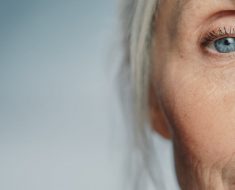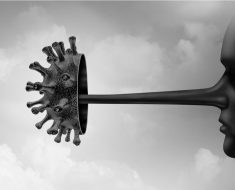It wasn’t the menopause! For years, Sue Perkins’ partner Anna battled with mid-life weight gain and tiredness, then she discovered a problem with her thyroid…
- TV presenter Anna Richardson, 48, was recently diagnosed with the menopause
- She religiously took HRT in varying doses in the hope it would tackle symptoms
- However, she later discovered that the issue was actually a thyroid problem
Tiredness, irregular periods, brain fog and a thickening middle — to TV presenter Anna Richardson and her gynaecologist it spelled one thing: the menopause.
So, each day for the past three years Anna, 48, the partner of former Great British Bake Off presenter Sue Perkins, 49, religiously took HRT in varying doses in the hope that it would alleviate her symptoms. But far from showing any improvement, she got worse.
‘I’d go to bed at 10pm and still not be up at 11 the next morning and Sue would say: “For God’s sake, get out of bed, you’ve been in there for hours, you’re sleeping way too much”,’ says Anna, whose TV credits include Supershoppers, Loose Women and Naked Attraction.
‘The brain fog was awful, too — I would keep forgetting people’s names and even the words for everyday things. I’d end up having to describe them: “You know, that thing you put in the other thing that makes it go round.”

Partners: Sue Perkins with her girlfriend, Anna Richardson, who was misdiagnosed as going through the menopause – causing an array of symptoms…
‘I kept going back to the gynaecologist I was seeing privately every few months, saying this HRT still isn’t working — and we would increase the dose again.
‘But I was still overwhelmingly fatigued. Over about 18 months I also became a stone heavier than I should be, despite eating relatively healthily — and it wouldn’t go, it clung around my middle. It was very frustrating.
‘I thought it odd that I should be going through the menopause so young, but when you are told by experts that you are menopausal, you accept it.’
Then, earlier this year, other symptoms started to emerge.
-

French hospital is overrun with volunteers trying to donate…
Heartbroken mother reveals her six-week-old son died just…
Cancer survivor, 25, to have a pioneering operation to…
Breast implants MUST be properly regulated, warn experts…
Share this article
‘I was cold all the time — Sue would come home and say: “It’s boiling in here” because the heating was turned right up, but I would be freezing,’ says Anna.
‘I also started to get more colds — I had one in September that lasted a week, then a week later I picked up a chest infection that has only just gone.’
Two months ago, alarmed that she was getting worse, she returned to her gynaecologist yet again. ‘I’d had enough. I thought, something isn’t right. This is not just the menopause,’ she says.
Her gynaecologist ran more blood tests and found the true cause of Anna’s symptoms: an underactive thyroid, where the thyroid gland — a small, butterfly-shaped organ that sits on either side of the windpipe — doesn’t produce enough of the hormones, such as thyroxine, needed to maintain a normal rate of metabolism.

Fact: Up to 2 per cent of the population have an underactive thyroid and Hashimoto’s disease is the most common cause. It occurs when antibodies mistakenly attack the thyroid gland
Further tests are pending, but it’s thought Anna’s problem may be caused by a benign tumour on her pituitary gland — the master gland in the brain that signals to the thyroid to produce thyroxine — or the autoimmune condition Hashimoto’s disease.
Up to 2 per cent of the population have an underactive thyroid and Hashimoto’s disease is the most common cause. It occurs when antibodies mistakenly attack the thyroid gland.
Anna’s gynaecologist made the diagnosis after a blood test for the antibodies came back positive. She was then referred to an endocrinologist but, unusually, a second blood test came back clear, so she is waiting to have scans of her pituitary gland.
‘My levels of thyroid hormone are 12, which is borderline normal — they can be 12 to 20 — whereas in 2011, when I had them checked as part of a general MoT, they were 19, and normally they don’t change much — so clearly something has had a massive impact on my thyroid gland,’ says Anna. Symptoms of an underactive thyroid — whatever the cause — do get mistaken for the menopause or sometimes simply old age, as they are similar.
Tiredness, weight gain and susceptibility to the cold are common as the metabolism is slowed, but in fact other processes slow, too: from heart rate to protein production (which means aches and pains are common) to brain fog and memory issues (as cognitive function slows).
Even the rate at which waste is pushed along the bowel can be affected, so another possible symptom is constipation.
It can also affect the production of hormones needed for fertility, so it can cause irregular periods and difficulties in conceiving.

Did you know? Hashimoto’s is more common if you have another autoimmune disorder such as type 1 diabetes or rheumatoid arthritis — and there can be a genetic element
‘A lot of people with this are undiagnosed,’ says Simon Pearce, a professor of endocrinology at Newcastle University and programme secretary at the Society for Endocrinology.
‘That’s because there is a strong overlap with symptoms of other conditions, the menopause especially. Some women may not be menopausal at all, whereas others may have an underactive thyroid gland as well as being menopausal.’
Hashimoto’s is more common if you have another autoimmune disorder such as type 1 diabetes or rheumatoid arthritis — and there can be a genetic element.
But the biggest risk factor is being female because, as with all autoimmune disorders, Hashimoto’s is more common in women — they are ten times more likely to develop it, according to figures from the British Thyroid Foundation.
To muddy the waters further, Hashimoto’s often starts to cause symptoms when a woman hits mid-life.
Professor Pearce explains: ‘The antibodies that attack the thyroid gland can be present from the teenage years or from the 20s or 30s — and in the initial phase, when the thyroid is still functioning quite well, some people don’t have any symptoms at all.’
The disease progresses slowly and most of those with Hashimoto antibodies never develop symptoms — only 2 per cent eventually get thyroid underactivity as a result, says Professor Pearce.
Yet detecting and treating the disease with levothyroxine, an artificial form of the hormone thyroxine, is important.
‘If it goes untreated, you start to slow down further and potentially go into a coma — it’s like a form of hibernation,’ says Professor Pearce. At this point, all the bodily functions are slowed to such an extent that it can prove fatal.
Living with an underactive thyroid gland can be life-changing, as Anna can testify. ‘It has impacted on my life hugely, to the point that I avoid socialising much because I am too tired,’ she says. ‘Recently, I had to cancel a couple of charity events because I was too tired and my brain isn’t as sharp.’
Anna has taken the rest of the year off to give her time to have tests. And she has gone back to the NHS. ‘They are looking at my pituitary gland — the thinking is it might not be talking to my thyroid gland for some reason,’ she says.
It would be an odd coincidence if it does prove to be a tumour on the pituitary gland, as Sue, her partner since 2013, has one as well. She revealed in 2015 that she has a benign tumour called a prolactinoma which affects the secretion of hormones needed for fertility — Sue now takes medication and sees an endocrinologist regularly, says Anna.
‘Now we sit and compare notes — “have you put on weight round your middle? So have I” — that sort of thing. Between us we have been on a journey.’
Tumours on the pituitary can have various effects. Some may produce excess hormones such as prolactin, which in excess can affect fertility. Others cause problems such as headaches by applying pressure to the gland. Treatment varies according to the type of tumour.
For now, Anna is taking a low dose of levothyroxine — 50mcg a day — and ensures she gets ten hours’ sleep a night. ‘If I don’t, I feel awful,’ she says. ‘It has been a long and expensive journey getting to this point. Yet it’s quite a relief to be able to put some kind of label on this.
‘When you say to people: “Oh, I’m perimenopausal, I’m on a (HRT) patch, but I don’t feel great,” they roll their eyes as if you’re just lazy. It’s a relief to be able to say I have a thyroid problem.
‘There is probably a whole generation of women who are underdiagnosed with thyroid issues and aren’t being investigated. I want a hoodie top with the slogan: “It’s not me, it’s my hormones.” ’
Anna Richardson’s six-part podcast series, Health Fact vs Fiction, in association with HCA Healthcare UK, is now available on Apple Podcast and all other podcast platforms.
Source: Read Full Article





